Pockets Of Value And The Funds To Take Advantage

It has been an interesting few months for investors with the different sectors and asset classes experiencing a wider than normal range of returns. Amongst the developed markets it’s the US that is leading the way, with the S&P 500 back in bull market territory, at least in dollar terms.
Since its low on 12 October 2022, the index is up more than 25%, while the NASDAQ has risen by over 40% due to the demand for all things AI. In the UK things have been much more muted, as is often the case, with the FTSE 100 climbing by around 12%.
For much of the last decade the gains in the American stock market were mainly driven by the large mega cap tech companies, although other shares also saw their values rise. This time around however, the positive return is almost exclusively due to the performance of just seven businesses: Apple, Microsoft, Amazon, Google, Nvidia, Meta and Tesla.
The lack of breadth casts real doubt on whether the US bull market is sustainable, especially as many other areas have been struggling. Higher interest rates have hit bonds and bond proxies like infrastructure hard, with the investment trusts operating in these sectors seeing their discounts widen considerably.
Given these underlying trends it is no surprise that technology trusts saw an average share price gain of around 20% in the first six months of the year, whereas the biotech, mining, smaller companies and multi-asset sectors experienced significant falls of up to 10%.
If the developed economies tip over into recession, as seems likely, there is a good chance that interest rates will not have to increase as much as currently feared. Were this to be the case there are some real pockets of value out there that could bounce back quite quickly.
Infrastructure And Renewables
Mick Gilligan, portfolio manager at Killik & Co, says that listed infrastructure funds have been sold off because the increase in interest rates has resulted in higher discount rates and lower valuations. This has been exacerbated by the widespread selling of FTSE 250 stocks by institutional investors.
“When it will recover is unclear, but any moderation in expected interest rate rises should be helpful. It is also possible that a private equity fund or pension investor could bid for an infrastructure trust. This happened with John Laing Infrastructure several years ago.”
In order to take advantage he recommends the £986m BBGI Global Infrastructure Trust (LON: BBGI), which he describes as being low risk, with a high quality portfolio and no utility or demand-based assets. It is currently trading on an eight percent discount and yielding 5.5%.
Rob Morgan, spokesperson and chief analyst at Charles Stanley, says that there seems to be a major asset allocation shift away from alternative income to traditional, more liquid and more certain fixed income markets.
“Investors should not forget that many of the cash flows of the underlying infrastructure trust assets have strong inflation linkage that should go a long way to offsetting changes in interest rates. Renewables trusts have also been caught up in the malaise, which seems unfair as the biggest sensitivities to the value of their cash flows − and therefore net assets − is the power price and the weather.”
While he acknowledges that there has been a softening in the forward power price, he thinks the sell-offs in the £750m Foresight Solar (LON: FSFL) and the £3.3bn Renewables Infrastructure Group (LON: TRIG) look overdone. These are trading on discounts of 20% and 12% respectively, with yields of 7.2% and six percent.

Multi-Asset Funds
Another area that has been adversely affected by rising interest rate expectations are the various multi-asset funds. Gilligan says that a number of these hold bonds with a two to five year maturity and also invest in some of the listed infrastructure funds, all of which have sold off as the Bank of England has moved short rates higher.
He recommends the £1.1bn Capital Gearing Trust (LON: CGT) that has a defensive mandate, but whose shares have fallen in recent months.
“If rates moderate this should be helpful to several of its holdings, including the infrastructure trusts. It has a zero-discount control policy so there is little risk of a material widening of the discount,” he says.
Its two closest rivals, the £1.08bn Ruffer (LON: RICA) and the £1.8bn Personal Assets (LON: PNL) have also struggled. They have both given up ground and are currently trading at a discount, which is very unusual, although the latter benefits from a discount control mechanism that should stop the situation getting any worse.
PNL aims to protect and increase (in that order) the value of shareholders’ funds per share over the long-term, while RICA tries not to lose money in any 12 month period and to grow the value of their investors’ wealth over the long haul. Year-to-date they have made share price loses of one percent and ten percent respectively.
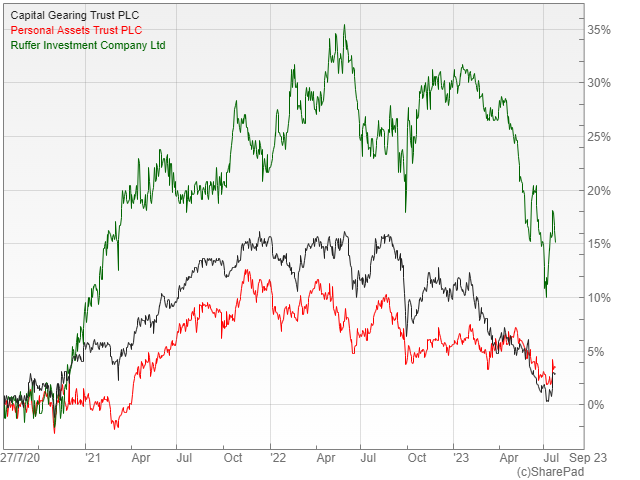
Smaller Companies
A higher risk area that has come under pressure is the smaller companies sector, as these types of businesses tend to be sensitive to changes in credit conditions and fare poorly as interest rates rise.
If you want to increase your exposure Gilligan recommends the £320m European Assets Trust (LON: EAT), which has a focus on quality and on companies with earnings growth potential. It is currently available on a nine percent discount.
“EAT pays a high dividend, currently 7.3%, supplemented from capital. This attractive yield should provide some support and help prevent the discount widening further from current levels,” he says.
James Yardley, senior research analyst at Chelsea Financial Services, says that the last few years have all been about large, mega cap tech stocks, with smaller companies around the globe being largely ignored.
“Smaller companies have historically delivered much better returns and better growth. The mega caps are starting to look expensive as money has crowded into this trade, while smaller companies have been left behind as fears of a recession linger.”
His preferred options in the sector are the £720m Global Smaller Companies Trust (LON: GSCT) that is available on a 13% discount and abrdn Global Smaller Companies.
Ben Yearsley, a director at Shore Financial Planning, says that everyone hates the UK and has been selling and that any liquidity crunch hits small cap stocks the hardest.
“This is what makes it such an interesting opportunity as over the long-term, UK small cap outperforms UK large cap and both are ridiculously cheap. For a recovery to happen you probably need peak interest rates and inflation to come down to give investors some confidence to invest again.”
He recommends the £200m Montanaro UK Smaller Companies Trust (LON: MTU) alongside River & Mercantile UK Equity Smaller Companies. The former is trading on a 12% discount and yielding 4.4%.
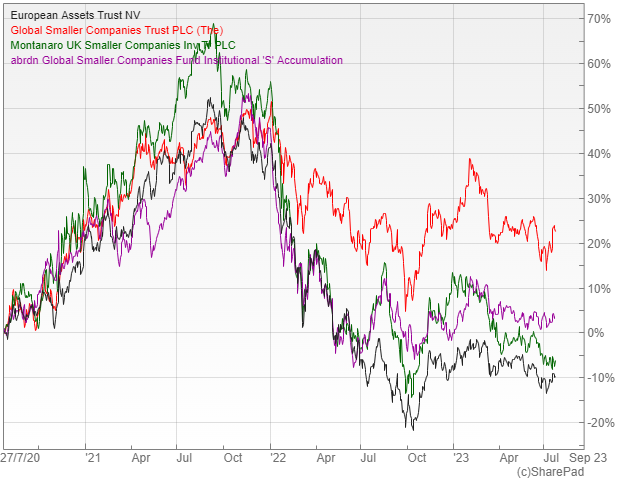
UK Equities
Ryan Hughes, head of active portfolios at AJ Bell, says that the UK has been unloved for a number of years, as political uncertainty and the ‘old fashioned’ makeup of the market has encouraged investors to look elsewhere.
“This has resulted in the UK looking cheap in comparison to other countries with a PE of 14 versus 22 for the S&P 500. While it hasn’t got the glamorous technology companies that have been driving the market higher, it does have a strong collection of international brands that aren’t reliant on the UK economy for their success.”
One option in this area is the £760m Temple Bar Investment Trust (LON: TMPL). The management was taken over by Redwheel a couple of years ago and their deep value approach has been well received.
“With the UK market on an overall discount, this trust focuses on companies that are out of favour, meaning the portfolio is valued on an even cheaper basis. It offers an attractive yield of over four percent and sits on a discount of five percent with the board actively buying back shares,” says Hughes.
The UK has not experienced the upside momentum that other developed markets have so far this year, but even so, the more severe economic outlook means that it is still susceptible to downside moves, so it is important to bear that in mind before investing in this area.
“Given the more persistent inflationary outlook and an economy facing the headwind of higher interest rates taking their toll on consumers and businesses, it is not surprising that sentiment remains febrile. However, the resilience of company earnings and the scope for increasing M&A activity could provide some positive surprises later in the year,” notes Morgan.
He is wary of pure recovery and contrarian funds that have to negotiate lots of value traps, but likes Man GLG Undervalued Assets because of its disciplined approach to value investing with an emphasis on financial strength.
“The managers target companies whose share prices do not fully reflect their ‘intrinsic’ value and those whose profit streams are undervalued by the market. This should weed out the majority of companies likely to fall victim to shaky balance sheets,” he says.
Alternatively Yardley suggests a focused fund like AXA Framlington UK Mid Cap, or TM Tellworth UK Smaller Companies, both of which have excellent stock pickers at the helm. Or you could go for a fund that can invest in companies of all sizes like IFSL Marlborough Special Situations.
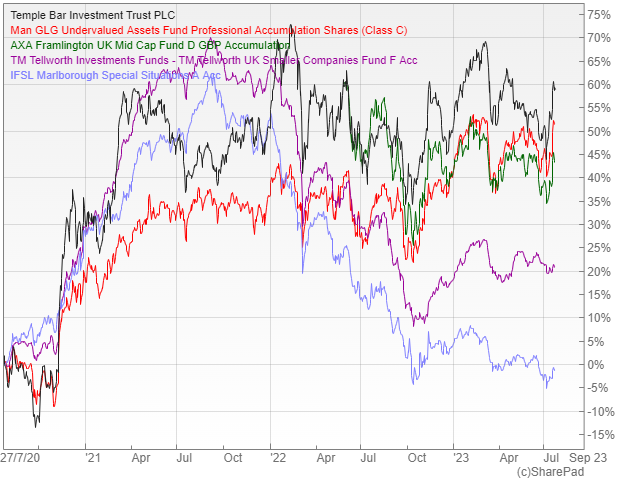
Fixed Interest
Some parts of the fixed income market are now paying a decent yield for the first time since the global financial crisis. Short-dated investment grade and government bonds have relatively low interest rate and credit risk, which makes them a fairly safe option.
Yardley says that even if interest rates keep rising from here, investors should still make a decent return, hence his recommendation of the AXA Sterling Credit Short Duration Bond fund.
“Manager Nicolas Trindade invests in high quality corporate bonds with expected maturities of less than five years. He also structures the portfolio so that it is well diversified with around 20% of the holdings maturing each year.”
Investment grade UK bonds are down over 20% in the last 18 months, which is a painful loss for an asset that many see as lower risk. Falling prices means higher yields and while there is still uncertainty over the path of inflation and interest rates, it seems likely that the back end of this year and into next should start to see inflation come down.
“As the economy slows, the pressure on central banks to keep on raising interest rates should start to subside, which should be positive for bond prices and there may well be cuts as we get into early 2024 that would see bond prices rise,” explains Hughes.
He likes Artemis Corporate Bond, as manager Stephen Snowden has built an experienced team around him and operates a high conviction approach where he is willing to invest away from the benchmark. The fund now offers a yield to worst of comfortably over six percent, which looks appealing should interest rates and inflation start to fall back in 2024.
Morgan says that he has been negative on UK gilts for a long time, but he is now seeing real value emerge, particularly in the medium to longer part of the yield curve.
“As the Fed, BoE and the ECB continue to pursue contractionary monetary policy, there is a growing risk that recession could be more severe than anticipated should they continue to hike interest rates in the face of stickier inflation. This would be bad news for equity markets, but squashing inflation at the cost of economic growth would be positive for longer term bonds, which could benefit from both a repricing of lower longer term inflation and a potential flight to safety trade.”
He thinks that 10-year gilts with a yield of around 4.6% look like they are in a sweet spot in the curve. Yields have moved substantially higher over the last couple of months, but it is noticeable that even after the BoE tightened by a surprise 0.5%, the 10 year and above were reasonably well supported.
“Central Banks acting tough on inflation is eventually going to be good news for longer term government debt. Fund investors could look to the Lyxor Core UK Government Bond UCITS ETF as a decent proxy for exposure. The effective duration of the FTSE Actuaries UK Conventional Gilts All Stocks Index that it aims to track is around nine years,” he says.
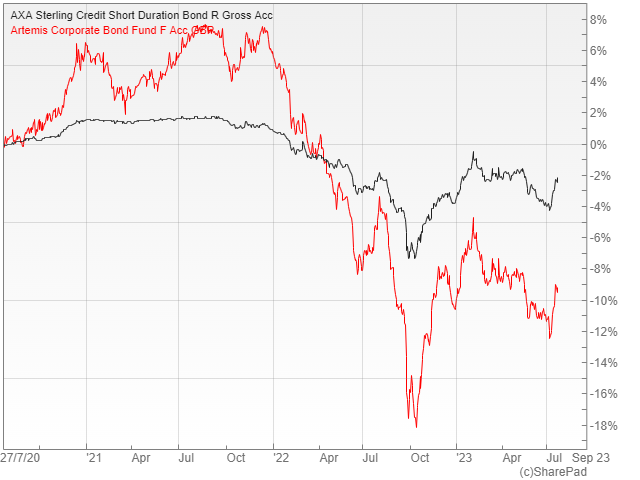
Asia
Another area with pockets of value is Asia. It has significantly underperformed other markets over the last two years, with the MSCI AC Asia ex Japan Index lagging the S&P 500 by 35% since the start of 2021.
The underperformancehas mainly been driven by weakness in China where investors have been concerned at the political situation, as well as the slowdown in the local economy. This has left Asian markets on a significant discount to other areas with the PE ratio coming in at around 13 compared to more than 16 for the MSCI AC World Index.
“While uncertainty across the global economy will no doubt be unhelpful in the short-term, looking further ahead, the region still has many attractive qualities including lower levels of indebtedness and a much younger, more dynamic workforce. As a result, for longer-term investors, this may represent an attractive valuation opportunity to add exposure to the likes of China, India and Taiwan to a portfolio,” says Hughes.
He singles out the £870m Schroder Asia Pacific investment trust (LON: SDP) whose management have built a long track record of outperformance across a variety of different market conditions.
“Currently the trust is significantly underweight China, but overweight Hong Kong with large exposure to both technology and financials in the region. It is on a discount of over 11% with the board actively buying back shares, which should limit the discount from widening further,” he says.
Yearsley is another fan of the region and says that there are large parts of it that are cheap and overlooked despite the excellent long-term growth potential on offer.
“Long-term, it’s the growth of the rising middle class consumer you are buying alongside the new manufacturing hubs of the world. The catalyst for improved performance is better numbers from China and maybe some stimulus.”
He recommends a core fund such as FSSA Asia Focus alongside a more specialist holding like Fidelity Asia Pacific Opportunities.
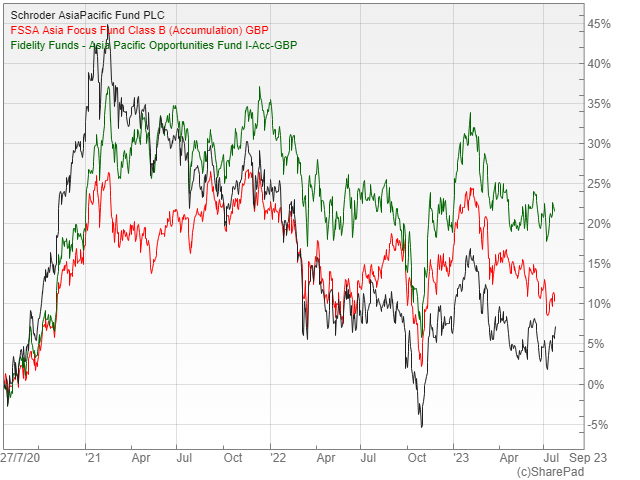
Comments (0)